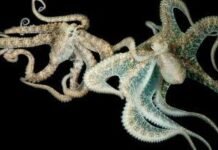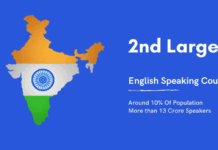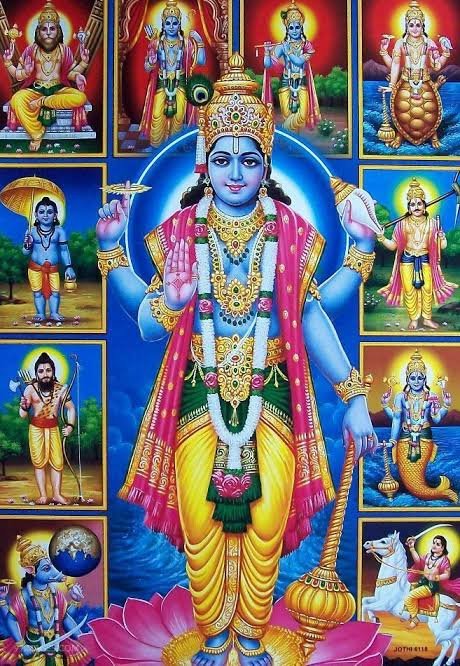Lord Vishnu, consists of ten incarnations and the principal deties of Hinduism.
Lord Vishnu, is one of the principal divinity of Hinduism. He is the foremost being within Vaishnavism, one of the major conventional of Hinduism. Lord Vishnu is known as “The Preserver” within the Trimurti, the trinity that encompass Brahma and Shiva. According to Vaishnavism lore, Vishnu is the predominant of all who creates, protect and transform the territory. According to the Shaktism lore, the divinity or Devi, is delineate as one of the pre-dominent yet Vishnu is esteem along with Shiva and Brahma.
A goddess is emerge to be known an energy and creative power(Shakti) with Lakshmi is equally harmonizing partner of Lord Vishnu. As he is one of the equivalent divinity in Panchayatana ( Shiva, Vishnu, Devi, Surya and Ista Devata) Puja according to Smarta tradition of Hinduism.According to the Vaishnavism tradition, the topmost form of ‘God’ is with the quality that have centre limitless, abstract and unvarying absolute Brahman and the intial soul and sef of universe.
A complex creature Lord Vishnu is the liberator and protector of men(Narayana), he preserve the order of things and when abligtory, he appears on planet in various avatars or incarnations to destroy the devil and ferocious creatures to maintain cosmic harmony and peace. The “Dashavatara”, is the ten primary incarnations of Lord Vishnu, the form of an avatar to reinpose comic order.
The ten incarnations of Lord Vishnu are as follows:
Matsya(Fish): The fish incarnation of Lord Vishnu, is often narrate as the first avatar of Vishnu’s ten avatar. Matsya recount to liberating the first men Manu from a great downpour. Matsya may be illustrate as a colossus fish, moreover golden in colour, or humanoid with the Torso of Vishnu associate with a rear half of fish.The preminary account of Matsya is broach in shatapatha Brahmana where Matsya is not coreated with a deity. The fish-libarator later amalgamate with the identity of Brahma in post-vedic era and later relate to lord Vishnu. The myth coreated with Matsya expand, evolve and vary in Hindu texts.
The folklore have implant with the Symbolism of small fish with Manu’s protection grows and became a big fish, and the fish rescue the planet. In later statement, Matsya slaughter the demons who have stolen the sacred scriptures- The Vedas and thus extol as liberator of the scripture.
Kurma(Turtle): The Turtle incarnation of Hindu god Vishnu. According to Vedic literature such as Yajurveda, Kurma is most commonly analogues with the myth of agitate of the ocean of Milk, introduce as Samudra manthan, the world-turtle supporting the planet, Kurma is itemize as a second incarnation of lord Vishnu.
The myth of agitate of the ocean of Milk(Samudra manthan) evolve in post-vedic literature itself inseparable link with Kurma and engaged with the son of Rishi Kasyapa and the demons(Danu and Diti) as a agitate to obtain Amrita. Guruda, the king of bird and ascend of Vishnu another son of Kasyapa also mentioned in this myth. Garuda quest the Amrita fabricate, eating conflicting between elephant and Tortoise or Turtle, ultimately the devines are able to achieve the Amrita.
Varaha(Boar): The Varaha incarnation of lord Vishnu in the form of a boar, the third incarnation of Vishnu. Varaha is most commonly coreated with the myth of heft the earth out of the cosmic ocean. When the demon king Hiranyaksha purloin the earth and concel her under the antediluvian water, Vishnu materialize as Varaha to rescue her.
Varaha destroy the demon and rectify the earth from the ocean, hoist it on his incisor and restore her in the universe.Varaha, portray as completely a boar or humamoid form, with a boar’s head and human body. His companion the earth is often portray as mother god, raise by Varaha.
Narasimha: The Narasimha is a undomesticated incarnation of lord Vishnu, one who enternalize in the form of part lion and part human to destroy evil creature and build up the religious faith from maltreatment and catastrophe on the earth and restoring of Dharma.
Narasimha emblem show him with a human torso and lower body, with a loin face and talon, typically with an evil demon Hiranyakshipu in his lap whom he is in process of conquer. The evil is the brother of another evil Hiranyaksha, who also king defeated by Vishnu. Hiranyakshashipu achieve special power from Brahma by he could not being diminished in day or night, inside or outside the house, any place of the world neither in galaxy, nor in land, nor in haven, nor in patal, by an ammunition, and by man, god, demons or animal that equip the new power.
Hiranyakshashipu creates disarray aggaign all devotes of Vishnu including his own son. Vishnu understand the power of demon, then he innovatory he adopts the mix incarnation of man and animal to kill demon at the coupling of day and night, inside and outside. Narasimha is primarily known as “great protector” who specifically protect all positive power and diminish the evils nagative power from earth. The most popular mythological character Narasimha protect his devotee Prahlada, and destroy Prahlada’s father the demonic creature Hiranyakshashipu.
Vamana: The fifth incarnation of Lord Vishnu, in the Rig Veda Vishnu took three stalk: earth, haven and space between them. The incarnation of Vamana made his aspect that the demon king Bali captured and ruled all over the universe. One day Vamana visited to the enclosure of King Bali and begged him as much as land he could step over in three stride. The king in very cheerful manner accepted the proposal of Vamana.
Vamana with one stride covered the whole planet, and with the second stride between the earth and heaven, as there was nowhere let to go, the king suggest Vamana to place his third stride on the head of King Bali and from that day Lord Vishnu also get his new identity as Trivikrama(God of three steps).
Parasuram: Parasuram is the sixth incarnation of lord Vishnu, he carries number of attribute which include aggressiveness, combat and courage; as well as patience, preudence was predict to appear at the time when overwhelming evil prevailed on the earth. The Kshatriya class, with weapon and power he started abusing and abolished 21 times to cosmic equalirium.
He marry to Dhanani, an incarnation of Goddess lakshmi, he was also the guru of Bhishma, Dronacharya and Karna.
Rama: Rama the seventh incarnation of Lord Vishnu and one of the mody popular along with Parasuram and Buddha. According, to interpretation of Sikhism, Rama is mentioned as of the twelve deity as eighth bababhadra among the 63 Sapakapurusas.Rama is referred to chubis Avtar in “Dasam Grantha”.
Rama was to Kaushalya and Dasharatha, the rural of Ayodhya. His siblings were Lakshamna, Bharata and Shatrughna. He married Sita, who born and brought up in royal family of Mithila. Rama and Sita faced certain unexpected challenge and banishment for 14 years. All of their travails. The most notable point is kidnapping of Sita by the demons and the rural of Lanka is Ravana. The entire story of Rama and Sita, and their followers alisonically discussed on the basis of Social aspect, political aspects including the duties and responsibility on an individual.
Rama is a central protagonist in ‘Ramayana’, the entensive secondary literature and inspired performance art. The two verse such as ‘Adhyatma Ramayana’ a spritual and thelogical substance considered foundational by Ramanadi monestries, ‘Ramcharitmanas’- a popular verse that inspire the Ramlila festival.
Rama also found in the verses of Jainism and Buddhism, called as Purana or Padma in these text with the details variation from the Hindu versions.
Balarama: The Hindu God, one of the incarnation of Lord Vishnu. Balarama also known as Baladeva, Balbhadra and Sankarshana, the elder brother of Krishna. The two sobriquent associate with Hala(Plough) with refers to as his strength.
His strong association with farming, as the devine figure who use farm equipment as weapon when it required. Balarama’s importance in Indian culture has from ancient period around 2nd BCE, became the symbolism of the farmers.
Gautam Buddha: Gautham Buddha the promoter of Buddhism, the ninth incarnation of lord Vishnu. The Buddhism is reflection as the Brahmical traditions. The Buddha was include in Vaishnavism thought the mythological aspect of Vaishanava purana, where Buddha is adopted as the ninth incarnation of Vishnu.
The myth of Buddha first appread in pre-Gupta period, with the reference to ‘Doniger’, “Hindu came to regards Buddha as an incarnation of Lord Vishnu between 450 AD and 6th century”, first appread in Vishnu Purana (400-500 CE).
Kalki: Kalki is the tenth incarnation of Lord Vishnu, who will appear at the end of Kali Yuga, to diminish the wicked and establish the Dharma. Kalki is establish in Puranas as the incarnation who reconstruct the Dharma to remove adharma and indemnity to Satya Yuga, The aspection of Kalki are different in various Puranas, Kalki is also found in Buddhist text such as Kalachakra Tantra and Tibetian Buddhism.
The order of the incarnation were being reflected in modern era, as a evolution of consciousness.
“Romanticism”is aptitude of literature in 19th century, with endowment of certain authors.












































